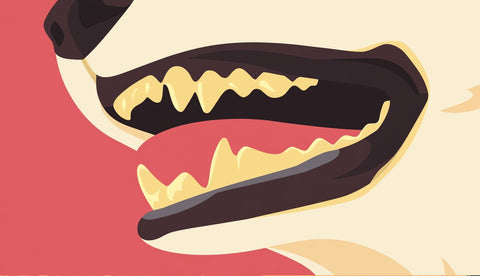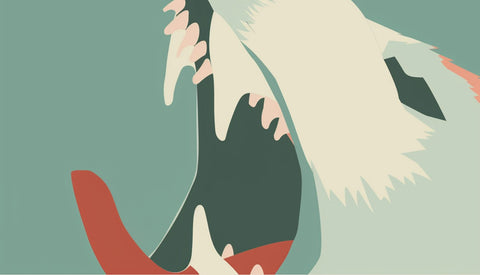We all want our dogs to have bright, shiny smiles, but getting them to let us brush their teeth can be tricky! If we don't brush our dog's teeth regularly, a sticky film called plaque builds up on their teeth.
Over time, this plaque hardens into tartar, which looks like a yellow or brown crust on their teeth! Tartar can make life a little uncomfortable for our pets, it can cause smelly breath, sore gums, and even make their teeth loose.
So, how can we clean tartar from our dog's teeth and keep their smiles healthy?
In this article, we'll talk about the difference between plaque and tartar, the problems they cause, and the simple things you can do at home to keep your dog's teeth clean and healthy.
Tartar vs Plaque: What's the Difference?

Both plaque and tartar are bad news for your dog's teeth, and we need to take good care of their mouths to keep them at bay. But what exactly are they, and how are they different?
Plaque is like a sticky, white film that gathers on your dog's teeth and gums. It's made up of bacteria, food bits, and saliva. If we don't brush our dog's teeth, plaque can build up and lead to tooth decay, gum disease, and eventually, tartar.
Tartar is what happens when plaque gets hard. It's like the plaque turns into a crusty, yellowish-white substance that sticks to the teeth! It is really hard to remove on your own, which is why it's so important to clean tartar from your dog's teeth before it forms.
Tartar can even be found along the gum line, behind the teeth, on the roof of the mouth, and under the tongue. It doesn't just look bad, it also smells bad! That's why tartar can give your dog really bad breath.
Why Are Tartar and Plaque So Bad for Our Dogs?

Tartar and plaque are more than just a bad smell! They're full of bacteria that can damage your dog's teeth. This can lead to cavities, gum disease, infections, and even tooth loss – all part of something called periodontal disease.
Periodontal disease is actually really common in dogs. It's like a nasty infection that makes their teeth and gums hurt. Imagine having a toothache – it's not fun! When your dog has periodontal disease, chewing and eating can be painful, and they might not want to eat as much.
But the problems don't stop there. If left untreated, bad teeth can actually affect your dog's whole body! It can lead to problems with their heart, kidneys, and liver. That's why it's so important to clean tartar from your dog's teeth and keep their mouths healthy. The sooner you start taking care of their teeth, the better!
How to Spot Plaque on Your Dog's Teeth?

It's pretty easy to tell if your dog has plaque, especially if you haven't brushed their teeth or given them a dental chew in a few days. Plaque forms quickly!
To check, gently lift your dog's lip with your fingers and look closely at their teeth and gums. You might see a white, sticky film or a slight yellowing around the gumline. This is plaque!
If you see plaque, it's a good reminder to clean tartar from your dog's teeth before it gets worse.
Why Does My Dog Have Tartar?
Remember that sticky film we talked about, plaque? Well, if we don't brush our dog's teeth regularly, that plaque can harden into tartar. It's like the plaque turns into a rock!
The minerals in your dog's saliva actually cause the plaque to harden, making it much harder to remove. Always remember to keep your dog's teeth clean and prevent tartar from forming in the first place!
How Tartar Can Affect Your Dog's Health?
Tartar can cause a whole host of problems for your dog, not just bad breath! Here are some of the most common issues:
- Smelly breath: This is an obvious sign of tartar, as it really doesn't smell nice!
- Gum disease: Tartar makes gum disease much more likely. Your dog might have sore, bleeding, or receding gums.
- Tooth decay: Tartar can make teeth decay and rot, causing a lot of pain for your dog.
- Periodontal disease: This is basically a really bad infection in the mouth caused by tartar. It can lead to abscesses and even tooth loss.
- Heart problems: There's evidence that tartar and gum disease can cause inflammation that travels to the heart, leading to heart problems.
- Kidney and liver issues: Just like with the heart, tartar and gum disease can cause inflammation that affects the kidneys and liver.
- Jaw fractures: If tartar isn't treated, it can weaken your dog's jaw, making it more likely for them to break their jaw.
All of this shows just how important it is to clean tartar from your dog's teeth before it leads to these serious health problems.
Clean Tartar From Your Dog's Teeth With No Vet
Now that we know how bad tartar can be, let's talk about how to get rid of it! There are some things you can do at home to help clean tartar from your dog's teeth. Here are 6 easy tips:
Regular Brushing:
Regular brushing is the best way to keep your dog's teeth healthy and free of plaque and tartar. It's like giving your dog a daily cleaning for their mouth!
The ideal time to start brushing your dog's teeth is when they are puppies, around 6 months old. It's much easier to get them used to it when they are young. But don't worry, you can start a brushing routine at any age!
Use an organic toothpaste and bamboo toothbrush that are specifically made for dogs. Human toothpaste can be toxic to dogs, so it's important to use the right products.

The Pure and Natural Pet’s kit combines a super-soft bamboo toothbrush with a delicious, organic toothpaste made with sweet potato, coconut oil, cinnamon, and peppermint.
We'll talk more about how to introduce brushing to your dog in another post, but remember that regular brushing is the best way to clean tartar from your dog's teeth and keep their smile bright!
Chewing for Clean Teeth:
Dental chews are a great way to help your dog's teeth stay clean. They help clean both gums and teeth, making them a beneficial addition to your dog's dental care routine. While not a replacement for brushing, they offer a natural alternative to rawhide.

Sparkly Tails has lots of different types of dental chews to choose from. The chewing action helps to stimulate your dog's gums and break down plaque that might be building up on their teeth.
Water Flossers for Doggy Dental Care:
Water flossers are a great tool to add to your dog's dental routine. They work by using a powerful stream of water to act like floss for your dog's teeth. This can help to remove plaque and soften any tartar build-up.
The water gets between their teeth and helps to clean away food particles and bacteria. It's not a replacement for brushing, but it's a great addition to your dog's overall dental care.
Just remember that water flossers are best used alongside brushing, dental chews, and a healthy diet. They won't be able to completely clean tartar from your dog's teeth on their own.
Veggies and Fruits:
You might be surprised, but some veggies and fruits can actually help your dog keep their teeth clean. They're like natural toothbrushes for your pet!
Give your dog a piece of apple or a peeled carrot to munch on. The chewing action helps to scrub their teeth and massage their gums. It's a healthy and fun way to help prevent tartar build-up and keep their mouths healthy.
Dental Pastes, Wipes, and Sprays:
If your dog isn't a fan of brushing, dental pastes, wipes and sprays are great alternatives! For an extra boost of freshness and protection, try this organic plaque & tartar removal dental paste by Pure and Natural Pet.
This natural formula, made with oils and mint extracts, gently cleans teeth and freshens breath, all without harmful chemicals or preservatives. It's a safe and effective way to keep your dog's vital organs safe while promoting healthy gums and fighting plaque.
Gum Massage for Your Dog:
Believe it or not, a simple gum massage can actually help your dog's teeth stay healthy.
If your dog enjoys a little bit of pampering, try gently massaging their gums with your fingers. This helps to:
- Stimulate blood flow: This brings more oxygen and nutrients to the gums, keeping them healthy.
- Increase saliva production: Saliva helps to wash away food particles and bacteria.
- Disturb plaque and tartar: The massage can help to loosen up any plaque or tartar that has started to build up.
- Reduce stress: Most dogs find a gentle massage relaxing!
Plus, getting your dog used to having their mouth touched can make it easier to brush their teeth or perform other dental procedures in the future. It's a win-win!
When to Call in the Experts…
If you're starting to worry about your dog's dental health, or if they don't like brushing, dental chews, or other dental care methods, don't hesitate to ask your vet for advice. They can give you personalized recommendations based on your dog's specific needs.
It's also important to see your vet right away if you notice any signs of plaque or tartar buildup, mouth pain, sore or bleeding gums, excessive drooling, or bad breath. These could be signs of a dental problem that needs professional attention.



